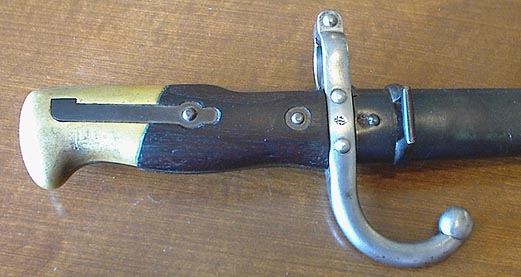Sword Bayonet

This bayonet was the last of the French "sword-type" bayonets. It was manufactured to fit the French Model 1874 "Gras"
Infantry Rifle, basically a refinement of the Model 1866 Chassepot Infantry Rifle. The "Gras" was manufactured from 1874 to about 1885.
This bayonet has a solid brass pommel with integral latching mechanism (push-button/spring-steel). Grips are wood. Crossguard is steel, usually "blued," with upper guard
being the muzzle-ring, lower guard forming a hooked "blade-breaker" quillon.
Blades are steel - well made - and triangular (3-edge) in form (very sturdy as a thrusting weapon). The blades are usually marked on the back-edge (opposite
the bottom cutting edge) with the arsenal, month, and year of manufacture; this is done in engraved cursive fashion and will appear something like, "Mre d' Armes de St. Etienne Janvier 1874"
or perhaps "Mre d' Armes de Chatellerault Juin 1882". Contrary to
novice speculation, this is not the name of a lieutenant or major, nor is it a presentation date; in reality - as previously stated - it is the the exact month, year, and location of manufacture.
French arsenal locations I have observed are: Chatellerault, L'Deny Paris, Paris-Oudry, St. Etienne, and Tulle. There is also an arsenal located in Austria and these are marked Steyr.
The scabbards are usually blued sheet-rolled steel, semi-oval, tubular, with a ball finial.
These bayonets replaced the Model 1866 "Chassepot" bayonet (and corresponding infantry rifle), and were replaced by the French Model 1886 Lebel Bayonet (aka "Rosalie") (and corresponding infantry rifle).
Several other countries used this bayonet, including Greece (these are marked "Waffenfabrik Steyr" or "Usine de Steyr"), Germany (many modified variants),
Ireland, and others; Portugal also used a variant for their Portuguese
Kropatschek Navy Rifle, but their bayonet has a straight back-edge on the grip (no hump).
The French Model 1874 "Gras" Bayonet has a colorful history was used by the French Foreign Legion on more than one occasion.




